Traditionally, the mention of the word Agriculture seems to invoke another word in our consciousness : Soil. This is so because agriculture, especially planting is carried out only on the soil(or so we thought) , in fact good soil. Many, in fact hold the belief that planting can't possibly be practised without soil. How true is this belief?
Well, that belief is only true in the minds of those who haven't seen the various ways that plants have been cultivated without any involvement of soil. There are various ways of doing this, however, we will be focusing on one major alternative to soil in planting, this alternative for planting is also as abundant as soil on the earth, in fact even more abundant than soil, you guessed it already, yes, it is water.
In this post, we will be discussing how water can and has been used as the supporting medium for plant cultivation instead of soil. The techniques involved in making sure that you do not stop planting even when there is no available soil or the available soil is too bad for cultivation.
Here is a more realistic side, do you have a space in your compound, where you would have wished to practice agriculture, but you made the decision after you've covered the floor with concrete, worry not, for you can still plant as much as you want, just pay attention to the methods and requirements for doing so. If you also happen to have some rooms in your house that are going to waste, here is a method of planting that ensures optimum use of such rooms.
Well, then let's put a name to this method of planting without soil, using water as a replacement, it is referred to as Hydroponics. And that leads us to the question :
The main idea has been explained above, however, for a more official opinion, it is defined by Merriam Webster Dictionary as the practice of planting, where soil is replaced by nutrients-rich water or solution as the support medium. At times inert substances are also used.
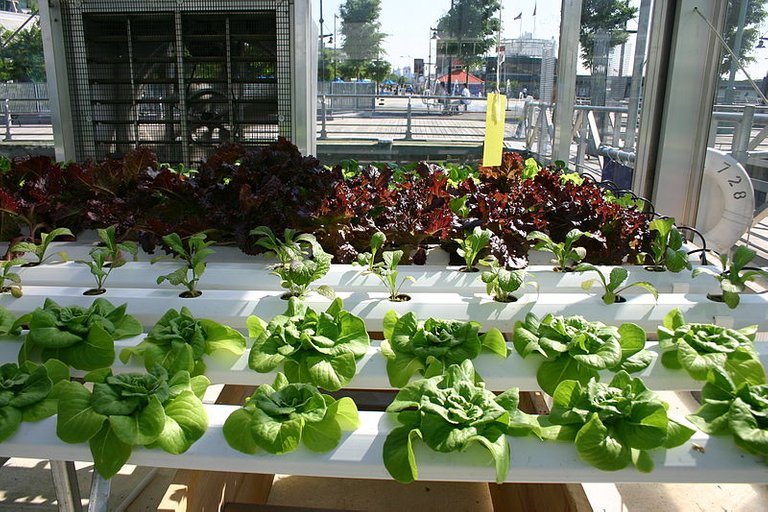
AN HYDROPONIC SYSTEM from Wikimedia under CCO license
It is of note here that water isn't the only option for replacing soil in planting, which is why there is also what is called Aeroponics. It may also interest you to know that the traditional method of planting in the soil that we have all come to know is referred to as Geoponics.
Let's take a while here before moving on, to break the age-long stereotype of "soil must be involved in planting". Assuming that you took some classes in Agriculture or Biology, then you must have learnt the requirements for the sustenance of plant life. Basically, for plants to grow, they need food, which is provided by photosynthesis.
For photosynthesis, to occur, there is need for sunlight, the chlorophyll in the plant's leaf, carbon dioxide and water. The chlorophyll in the presence of sunlight combines water and carbon dioxide to produce glucose and oxygen. Well, that is all. Now, you can choose to read that again hundred times, but you certainly wouldn't find soil anywhere there. That goes to show that soil is not a compulsory element of plant cultivation.
Why then do we use soil, you may ask. The answer isn't far fetched. Apart from photosynthesis, plant need water and nutrients to remain healthy and survive, and this is where soil came in, as it can provide both of these things. Let's take a pause here, we have established the major role of soil in planting cultivation here, so we could summarise it as :
Soil provides water and nutrients to the plants.
What, then, if we can fund an alternative medium to supply water and nutrients to the plants? Well, I don't think there is a more fitting replacement than the medium that is actually itself a compulsory requirement - water. This concept is what birthed Hydroponics.
It is worthy of your attention that as many who know about hydroponics hold the belief, it is not a discovery of the 21st century, as cultivation without soil can be traced as far back as 1627 in a book written by Francis Bacon, titled A Natural Historywhere he first discussed cultivation without soil. And since then a lot of research has gone into what has now become a mainstay in today's agriculture.
However, the term has been used to refer to other means of planting that do not require soil. However, for the sake of this discussion, it's use will be limited to planting in water with dissolved nutrients and the use of substrates that support the roots of the plants.
This last point leads us to one very big decision you will have to make if and when you decide to practice hydroponics, whether you will just go with water as the singular medium or employ the substrates. Hence, let me familiarize you with the options you will have to choose from.
Suppose you choose to plant with just the nutrients dissolved in water, here are the different ways you can choose to plant :
- STATIC SOLUTION CULTURE : In this case, there are containers that hold the dissolved nutrients mixture, and it is in these containers that the plants are grown. These containers vary from plastic containers or buckets to tubs or tanks. A hole is cut on the top of the containers to accommodate the plants. The amount of plants you plan to have informs the size of your container.
However, due to the fact that the nutrients have been dissolved in water, there will be need to prevent algae formation, this is simply done by covering the container with materials that block light from getting to the nutrients solution. To do this at home you may get aluminium foil or black plastic, or anything else that can do the job.
Also, due to the fact that plant roots need oxygen, there should be a system for aerating the root zone, but in case you can't afford or get such, make sure the solution level is kept low enough to allow the roots get air.
For efficient supply of nutrients though, there will be need for a scheduled change of nutrients solution. Also, if you could afford an electrical conductivity meter, you could use it to measure how much the concentration of the solution has decreased and adjust accordingly.
- CONTINUOUS FLOW CULTURE : The very popular type of this is the Nutrient Film Technique. As the name implies, the nutrients solution doesn't constantly stay with the roots, instead the solution is intermittently made to flow past the root system of the plants. So unlike the buckets mentioned above, you need a sort of channel, where the roots sit and where the flowing solution can touch the roots. The upper parts of the roots are exposed to get air.
Also, a tank or reservoir is needed for the mixing and adjustment of the nutrient solution before circulating the solution to the plants. This feature makes this technique easier to manage than most other techniques. However, to get the best out of this method, the following need to be achieved :
Right channel slope : Although, slopes of 1:100 have been recommended, there may be issues of ponding and waterlogging along irregularities in the channel, therefore slopes of 1:30 to 1:40 have been found to reduce these problems. However, each crop's water and nutrients requirement should be a major factor in eventually selecting a channel slope.
Right flow rate : The nutrient solution has to flow at a reasonable speed to efficiently supply the nutrients. To achieve this, 0.5 liter per minute is recommended at the point of planting the crops. This rate can then be doulbled to 1l/m, the maximum recommended flow rate is 2l/m.
Right channel length : A very long channel can lead to depletion of a nutrient like Nitrogen. Therefore, the length of the channels shouldn't exceed 10-15m. However, if one plans to have channel longer than this, it is suggested to have a point halfway the channel where nutrients can also be fed into the system.
Usually, other methods of hydroponics have serious trouble balancing an adequate supply of air, water and nutrients. However, the NFT balances all three very well, thus leading to better yield over time. This is it's greatest advantage over all other methods.
EBB AND FLOW OR FLOOD AND DRAIN : In this method there is a reservoir of nutrient solution fitted with a pump. On top of this reservoir is a tray which holds the plants (the plants are either in pots or on growing medium placed on the trays). This tray is filled with nutrients solution regularly, it is also fitted with a drain pipe, such that when the solution rises above this drain pipe, it is re-circulated into the reservoir. These systems usually work with simple timers which turn the pump on and off. Upon turning off the pump, the remaining solution drains back into the reservoir.
DEEP WATER CULTURE : in this case, the roots of the plants get suspended in nutrient solution that is held by a container, usually held by the lid of the container. The root zone is pumped with air for the root's consumption.
However, when plants just start growing, their roots may not extend far enough to reach the nutrient solution. Therefore a slight modification of this method is the Top-fed deep water culture, which where the nutrients are delivered exactly to the roots. A balanced use of this composite method ensures early maturity of crops.
- ROTARY METHOD : This is a commercial method of hydroponics, where the plants are grown in a regularly rotating circular chamber. R
The systems are typically designed to rotate every hour such that each plant turns 24 times each day. As this rotations occur, there is a periodic watering of the plants with the nutrient solution.
Some believe that these plants' struggles against gravity has a part to play in their quicker maturity. Also, each rotary chamber has an high intensity growth light which is controlled by a timer to simulate sunlight.
If you however decide to plant with inert porous media, below are the options you have :
- PASSIVE HYDROPONICS : Also known as hydroculture. Here, instead of the plant roots to be directly immersed in the nutrient solution, an inert porous medium is employed, examples of which include coconut husks and rock wool. The purpose of these inert porous media is to be the base for growing the plant, the medium is what then sits on the nutrients solution reservoir, such that it conveys water and fertilizer to the plant through capillary action.
As opposed to the other forms of hydroponics, this has some advantages, among which is the fact that the porous media used have more pore spaces allowing the roots to get more oxygen and also avoid root rot. Plants like some bromeliads and orchids, that are epiphytic in nature (naturally have their roots exposed) are easily cultivated using this method.
Barbosa (2015) pointed out that hydroculture yielded roughly ten times more than traditional agriculture in a controlled environment.
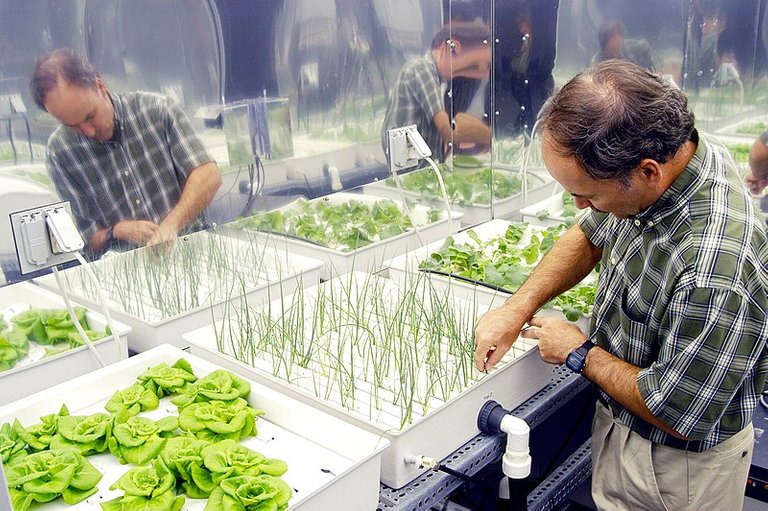
PASSIVE HYDROPONICS from Wikimedia under CC-BY 3.0 license
- RUN TO WASTE : It is also referred to as the Bengal system, owing to its invention in Bengal. In this case, the inert porous media are packed into a container, and the nutrients solution is either manually or automatically fed into the container to pass through the media, before leaving the container, either once or more times per day.
This frequency of application is affected by factors like climate, substrate, water content, plant growing stage and size. In more environmentally friendly applications, the waste nutrient solution is collected and filtered for reuse.
Welcome back from that journey of familiarisation with the different hydroponics techniques, I hope it was enlightening. Well, I expect that by now you must have repeatedly seen some terms in almost each technique. You've probably been puzzled about Growing medium or you'll want to know a bit more about Nutrient Solution. I also agree that you need to at least know some of their basics. Now, let's take a little time to examine both.
As an hydroponics farmer, one will have to decide which medium to grow his plants in depending on the particular method of hydroponics he has chosen. Below are some of the available media, and somespecific information are provided in relation to other media.
Grow stones : It is a product of glass waste. It has more space to retain water and air when compared with peat and perlite. Also holds water better than rice husks.
Rice husks : Also something else that could easily have passed for waste. Wallheimer (2010) commented that as they decay over time, they facilitate drainage and as mentioned above, they do not hold as much water as grow stones.
Rock wool : This is probably the most employed growing medium. Due to its fibrous nature, it aids capillary action and also accounts for its ability to hold plants firmly. You can choose to use it at the seedling stage or throughout the lifetime of the plant. They can hold water and air in large quantities and that is beneficial for root growth. A slight disadvantage though is that it might cause irritation on some skins.
Perlite : Made from volcanic rocks, b super heating them into expanded glass pebbles that are very light in weight. It has properties similar to Vermiculite, only that it has and edge with buoyancy, holding lesser water but more air.
Coir peat or Coconut husk : The left over from coconut she'll after the fibres are removed. It is said to stimulate root growth and also protects the root. It also posseses high cation exchange, meaning that minerals can be stored and then later released to the plants when required.
Vermiculite : This is also a mineral that has been expanded into pebbles by super heating. As earlie mentioned, it can retain more water than perlite and it has the natural ability to draw up water and nutrients from the solution (working).
Wood fibre : These have also found extensive use in hydroponics, and they have the advantage of keeping their structure for a long while, although it has been suggested that they may have negative effects on plant growth regulators.
Now to the nutrients.
Conventional hydroponics makes use of Inorganic hydroponics solutions, which are formulated with a basic knowledge of Plant nutrition, same as is applicable in Soil based agriculture. Same as in conventional farming, According to Sholto (1985), the nutrients are expected to be adjusted in line with Liebig's law of the minimum for every particular crop. Acceptable concentration ranges between 1,000 to 2,500 ppm.
However, to know more about the acceptable concentration of these nutrient ions are found here.
Please keep in mind that going below these concentration for the essential nutrients means you are inviting nutrient deficiency, while going beyond them can lead to a toxic environment for the plants.
Also, according to Jones (2004), Organic fertilizers are sometimes used to supplement or totally replace the inorganic solutions.
- Difference between Hydroponic Solutions Chemistry and Soil Chemistry
Almost all that has been explained above will be fruitless if it is not pointed out that the nature of nutrients uptake in the soil is significantly different from what happens between plant roots and hydroponics solutions.
The difference is explained below
- Since hydroponic solutions contain neither clay particles nor organic matter, they do not possess Cation Exchange Capacity,and for that reason,there can be rapid change in nutrient concentration and solution pH.
- There can be nutrients deficiency problems **even when the ideal quantity of nutrients is dissolved in the solution because plants tend to practice selective absorption of nutrients. For example Gericke (1940), pointed out that plants rapidly consume anions in the solution, leaving excess cations in the solution unabsorbed, this imbalance leads to cation deficiencies in the plants.
- Also, the presence of water contaminants and instantaneous pH can cause nutrients like Iron to precipitate, and thus become unavailable to the plants.
Additives like chelating agents and humid acids are added to hydroponic nutrient solutions to improve nutrients uptake.
There is certainly a lot to gain from practicing hydroponics, prominent among which is that there is increased yield and greater control on pests and diseases, there is also a measurable control on every aspect of your planting, including nutrients control and changes are easier to effect. Also, water is hardly wasted since evaporation is reduced and there is very little or no erosion
There are also some limitations to the practice. One of them is the issue of Cation Exchange Capacity, it is also time and energy intensive. More so, in some hydroponics systems, a failure of some of the components like water pump Cam cause irreparable damages to the plants.
Geoponics has been said to be planting on soil, and hydroponics refer to planting in water, however, there is also a method of planting in another natural resource that is probably even more abundant than both of them-yes, air. That method of planting is Aeroponics, please stick around for a detailed explanation of this on my blog before the week runs out. Thank you for your time.
Please find additional information on the practice of hydroponics in these references below
REFERENCES
Barbosa, Guilherme (2015). "Comparison of Land, Water, and Energy Requirements of Lettuce Grown Using Hydroponic vs. Conventional Agricultural Methods". International Journal of Environmental Research and Public Health. doi:10.3390/ijerph120606879. Retrieved 5 December 2017.
Gericke, William F. (1940). The Complete Guide to Soilless Gardening (1st ed.). London: Putnam. pp. 9–10, 38 & 84. ISBN 9781163140499.
J. Benton, Jones (2004). Hydroponics: A Practical Guide for the Soilless Grower (2nd ed.). Newyork: Taylor & Francis. pp. 29–70 & 225–229. ISBN 9780849331671.
Sholto Douglas, James (1985). Advanced guide to hydroponics: (soiless cultivation). London: Pelham Books. pp. 169–187, 289–320, & 345–351. ISBN 9780720715712.
Wallheimer, Brian (2010). "Rice hulls a sustainable drainage option for greenhouse growers". Purdue University. Retrieved August 30, 2012.
HYDROPONICS | WHAT IS HYDROPONICS | HYDROPONIC SYSTEMS 101
If you write STEM (Science, Technology, Engineering, and Mathematics) related posts, consider joining #steemSTEM on steemit chat or discord here. If you are from Nigeria, you may want to include the #stemng tag in your post. You can visit this blog by @stemng for more details.


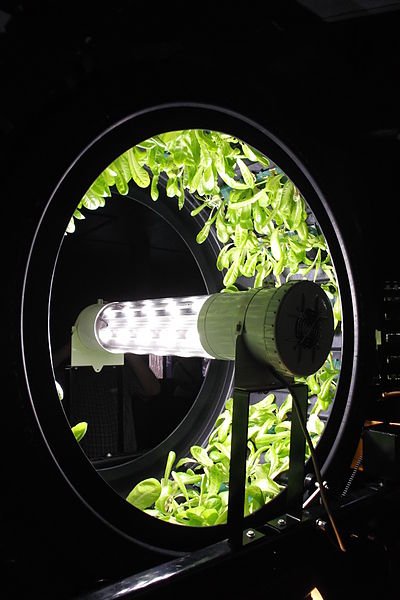
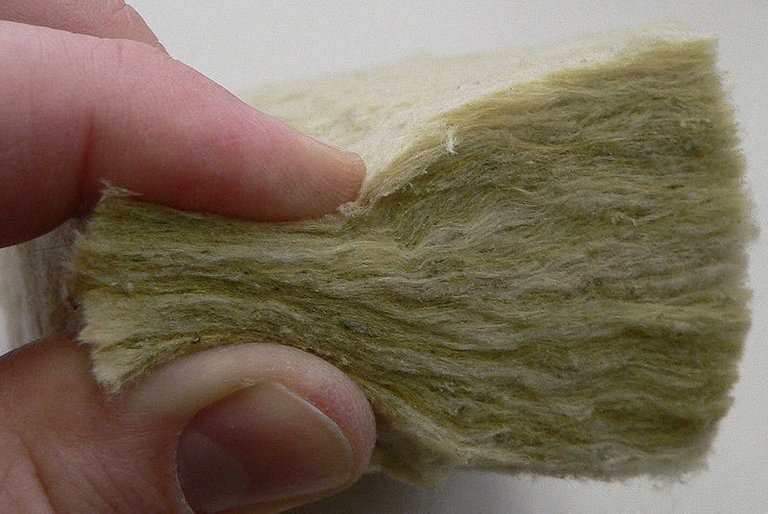
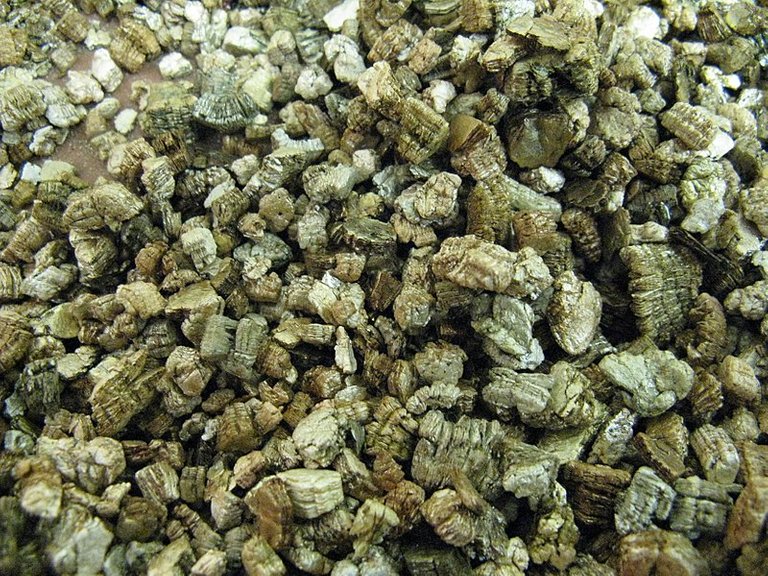
You continually find ways of making complex topics seem like ABC. But, I have a question, the cost of implementation not on the high side?
The cost of implementation actually depends on the method you select, for example, for someone practicing it subsistently, the Rotary method is a no go area, it is cost intensive.
Another angle is that in the long run, most of the hydroponic systems are more cost effective than Geoponics since they only get cost intensive at the start(for example, you wouldn't need seasonal tillage, or have to practice crop rotation), so over time, you'll reduce cost.
This is really insightful. Thanks for taking your time to reply.
Your post has been selected by Connect to the World FR
@cw-fr
We promote English posts in the French community!!https://steemitimages.com/0x0/https://gateway.ipfs.io/ipfs/QmYzPJNVRmfzfeMQKLKCtxSVxuw5KLbmKv3snEh2DJGPjg
By selecting 4 posts every 3 days that we recommend to read to the French community!!
Thanks for the great content!!
I feel honoured thatmy post post was selected, thank you.
Dear friend, you do not appear to be following @wafrica. Follow @wafrica to get a valuable upvote on your quality post!
Rock wool used for insulation can also be used in hydroponics can be used to practice hydroponics. The concept is brilliant coupled with the fact that one does not actually need soil to make plants grow. We used it in planting beans back in elementary school.
Brilliant, amazing and well explained @sogless.
I'm glad you were able to learn from it, hydroponics appeals to me mostly because I know the troubles you have to pass through as a Soil and Water conservation Engineer all because we want to plant on the soil. It makes this alternative all the more inviting.
Yes i am glad i read this.. Now lemme go and plant in my bucket 😁😁
Please do 😁😁
wow, what a good read! I particularly have learnt something new from this post as i have never come across the concept of hydroponics before.
Awesome job sir!
Thank you for reading, however, I'm more encouraged to be able to bring something new your way, I hope you will attempt it, even on a small scale as a test. Thanks for stopping by
Ofcourse i am thinking of giving it a try...some part of my house has been lying useless for s while, i guess its time to put it to use. At least i would have "ewedu" in abundance.
This is the first time I am reading such a topic. It is quite impressive, but I've got a lot of lands here so that I will be doing the conventional gardening with the soil. Thanks for sharing.
Thanks for reading, however, I also think that you could choose to practice hydroponics on the same land. This part of the post below was actually based on research.
Besides, since you have land, you can test both for yourself and then make your decision. I really appreciate your comment.
Exactly what I'm about to point out.... Hydroponics enhances more yield & pest control...
@bitfairy comma give me small land na
@mrbreeziewrites Land for sale: only 10,000 steem. Hahaha
Smh. I de kom
@sogless, I am an online farmer. I can only farm on top of my PC :)
Actually, we can practice NFT on your laptop, we just evacuate the keyboard space and use it as nutrients solution channel 😀😀
I can only try that if I have a damaged PC keyboard 😀
This is a good compilation sir. Hydroponics is one science that has been highlighted to aid in the colonization of planet Mars.
However @sogless, I do not really understand how the plants will be supported, unlike in soil planting where the soil serves as a support. Please clear me on this.
Thanks.
There are many ways to support them. Firstly though, many plants cultivated by hydroponics are vegetables, so these do not need elaborate support other than that provided by the surface of your container. However, stands are sometimes provided to hold plants that need extra support. Thank you for reading and for that very good question.
Thanks for your response sir.
Hydroponics, Geoponics, Aeroponics
These are all awesome concepts. Until today, I never knew what we knew of has a name, 'Geoponics'
Hydroponics definitely is interesting as explained o...
Maybe when I own a land, I might practice it.
Well-done. This is well written.
Glad I could add some knowledge, I hope you do practice it, I'll also be glad if you inform you when you eventually do. Thanks for reading.
No problem..I do hope it's in the nearest future
Congratulations @sogless! You have completed some achievement on Steemit and have been rewarded with new badge(s) :
Click on any badge to view your own Board of Honor on SteemitBoard.
To support your work, I also upvoted your post!
For more information about SteemitBoard, click here
If you no longer want to receive notifications, reply to this comment with the word
STOPHydroponics allows the plant to uptake its food with very little effort as opposed to the soil where the roots must search out the nutrients and extract them. Thanks for the heads up!
Yes, nutrients are made readily available to the plants in hydroponics, although, the Cation Exchange Capacity of clay particles help the plants grown in Geoponics to get a more balanced nutrient uptake. So without proper management of the hydroponics nutrient solution, the plants may eventually suffer.
Nice one bro👍
Comparing the growth and vigor of lettuce plants grown hydroponically with lettuce plants grown in soil in this fun and simple plant science project.
Nice piece.
Thank you for reading through, and for your encouraging comment.